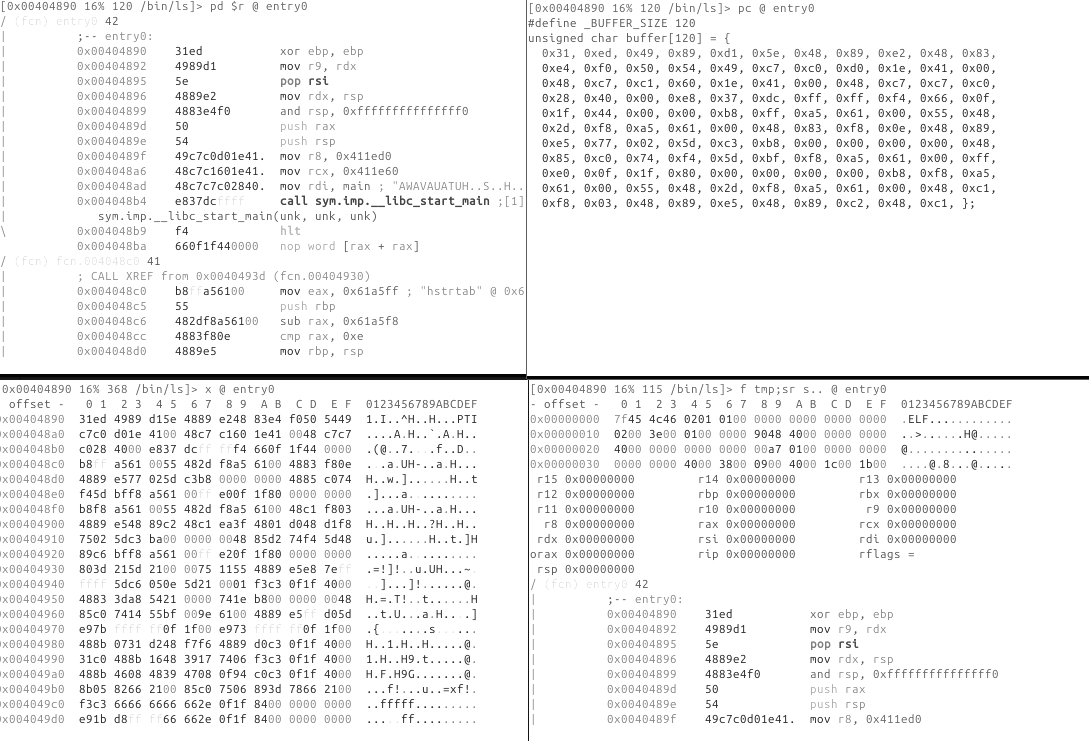Visual Mode
The visual mode is a more user-friendly interface alternative to radare2's command-line prompt. It allows easy navigation, has a cursor mode for selecting bytes, and offers numerous key bindings to simplify debugger use.
To enter visual mode, use V command. To exit from it back to command line, press q.
Navigation
Navigation can be done using HJKL or arrow keys and PgUp/PgDown keys. It also understands usual Home/End keys.
Like in Vim the movements can be repeated by preceding the navigation key with the number, for
example 5j will move down for 5 lines, or 2l will move 2 characters right.

Print Modes, a.k.a. Panels
The Visual mode uses "print modes" which are basically different panels that you can rotate. By default those are:
Hexdump panel -> Disassembly panel -> Debugger panel -> Hexadecimal words dump panel -> Hex-less hexdump panel -> Op analysis color map panel -> Annotated hexdump panel -> Hexdump panel -> [...]
Notice that the top of the panel contains the command which is used, for example for the disassembly panel:
[0x00404890 16% 120 /bin/ls]> pd $r @ entry0
Getting Help
To see help on all key bindings defined for visual mode, press ?:
Visual mode help:
? show this help
?? show the user-friendly hud
% in cursor mode finds matching pair, or toggle autoblocksz
@ redraw screen every 1s (multi-user view)
^ seek to the begining of the function
! enter into the visual panels mode
_ enter the flag/comment/functions/.. hud (same as VF_)
= set cmd.vprompt (top row)
| set cmd.cprompt (right column)
. seek to program counter
\ toggle visual split mode
" toggle the column mode (uses pC..)
/ in cursor mode search in current block
:cmd run radare command
;[-]cmt add/remove comment
0 seek to beginning of current function
[1-9] follow jmp/call identified by shortcut (like ;[1])
,file add a link to the text file
/*+-[] change block size, [] = resize hex.cols
</> seek aligned to block size (seek cursor in cursor mode)
a/A (a)ssemble code, visual (A)ssembler
b browse symbols, flags, configurations, classes, ...
B toggle breakpoint
c/C toggle (c)ursor and (C)olors
d[f?] define function, data, code, ..
D enter visual diff mode (set diff.from/to
e edit eval configuration variables
f/F set/unset or browse flags. f- to unset, F to browse, ..
gG go seek to begin and end of file (0-$s)
hjkl move around (or HJKL) (left-down-up-right)
i insert hex or string (in hexdump) use tab to toggle
mK/'K mark/go to Key (any key)
M walk the mounted filesystems
n/N seek next/prev function/flag/hit (scr.nkey)
g go/seek to given offset
O toggle asm.pseudo and asm.esil
p/P rotate print modes (hex, disasm, debug, words, buf)
q back to radare shell
r refresh screen / in cursor mode browse comments
R randomize color palette (ecr)
sS step / step over
t browse types
T enter textlog chat console (TT)
uU undo/redo seek
v visual function/vars code analysis menu
V (V)iew graph using cmd.graph (agv?)
wW seek cursor to next/prev word
xX show xrefs/refs of current function from/to data/code
yY copy and paste selection
z fold/unfold comments in disassembly
Z toggle zoom mode
Enter follow address of jump/call
Function Keys: (See 'e key.'), defaults to:
F2 toggle breakpoint
F4 run to cursor
F7 single step
F8 step over
F9 continue